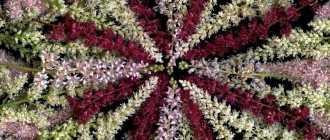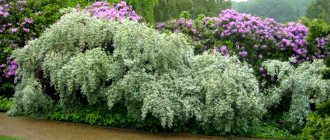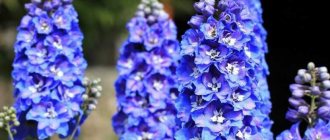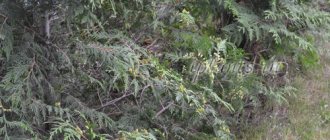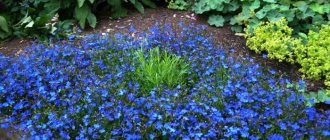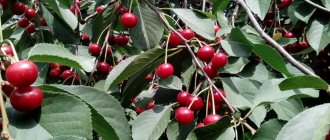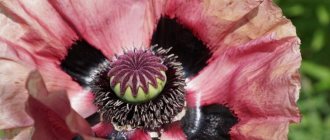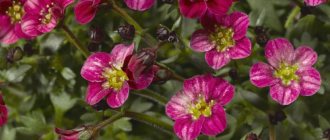Aquilegia is considered one of the most unpretentious plants that is used in folk medicine and in creating landscape designs. Its second name is catchment, and because of the unusual appearance of flowers, aquilegia received the unofficial name “flower of elves.” All the necessary information about such a plant is presented on the Agronom.guru portal.
Catchment (aquilegia)
Botanical description
Aquilegia belongs to the group of perennial herbaceous shrubs. Its root has a branched structure and consists of long, thin shoots. They grow over great distances in depth and width. Because of this feature of the root system, the bush is quite difficult to replant . This especially applies to specimens that have grown in one place for several years.
The length of an adult plant varies from 50 to 80 cm.
At the base of the trunk, leaves are arranged in several levels in the shape of a rosette. Their main growth occurs in the first year after transplantation into open ground.
Some plant species can be 1 m long
The leaves have a fairly long petiole and are cut into two or three equal lobes. Their maximum length does not exceed 5 cm and width 3 cm.
Aquilegia leaves are covered with a thin layer of wax.
Thanks to this feature, rainwater and dew do not wet them, but collect at the edges in the form of large drops. Lanceolate leaves are evenly spaced along the entire length of the stem.
One flower is formed on each shoot. Their maximum number on one stem is 12 pieces.
In the first ten days of July, the buds begin to bloom. The range of shades of the plant's flowers is quite large. The most common colors include:
- blue;
- pink;
- lilac;
- red;
- white.
Each flower stays on the plant for no more than 10 days, after which a new one blooms.
Richness of colors
Bright bloom
Garden decoration
Flower formula
The plant in question belongs to the ranunculaceae family. By analogy with other similar plants, the Aquilegia flower has the following formula *Х5Л5Т5+5+…+5П5.
Some interesting facts about the name of the plant
The name of the flower evokes an indescribable slight sadness. Etymologists have no consensus on its origin.
The Russian word “aquilegia” goes back to the Latin Aquilegia, formed either on the basis of the phrase aqua legere (to collect water), or from the word aquila (eagle). This is where the names of the flower given to it by the people came from: columbine, orlik.
They also call it differently: boot, dove, bell. There are also almost mythical names: Venus's slipper, elf's slippers.
The plant is distributed in different parts of the world, so it is not surprising that different peoples create their own legends about aquilegia. In America and Great Britain, the flower is called Columbine due to the variability of color.
The change in its color is transferred to people’s relationships and Aquilegia is considered a flower associated with betrayal and unrequited love. On the contrary, in European countries they primarily celebrate the tenderness, almost airiness, of plants. Here the flower is considered a symbol of the Holy Spirit or angels. Such flowers often decorate the gardens of monasteries and are called the slippers of the Virgin Mary.
Chemical composition
Flowers, trunk, roots and other components of the catchment have not undergone formal chemical testing. To date, the chemical composition is practically unknown.
It has been established that the plant contains two types of alkaloids: berberine and magnoflorine.
The seeds are rich in oils, fat content reaching 15%. It has been established that the raw materials contain the following elements:
- Ascorbic acid.
- Cyanogenic glycoside.
- Flavonoids.
The composition of the catchment has been little studied
Classification
Existing types of aqualegia are divided into three main categories:
- European. A special feature is the spur in the form of a ring or hook.
- American. All varieties of this group have a straight spur.
- Japanese. There is no spur on the bushes of this group.
In total, about 100 species of the plant in question are known and can be found in nature.
There are more than 100 varieties of aquilegia
Pharmacological properties
Due to its chemical composition, the watershed has the following effects on the human body:
- soothing;
- diuretic;
- diaphoretic;
- healing;
- antiseptic;
- pain reliever;
- choleretic;
- laxative.
The calming effect of the catchment provides peace of mind
Indications for use
There are a number of diseases for which the watershed can provide effective assistance:
- impaired kidney function, including the formation of stones;
- mild form of stomach ulcer;
- polyps formed on the mucous membrane;
- accumulation of bile;
- open bleeding of internal organs;
- non-infectious jaundice;
- disruption of the male reproductive system;
- inflammation of the throat and mouth;
- malignant and benign formations of the mammary glands;
- cellulite.
Water catchment is not only a beautiful, but also a useful plant
Contraindications for use
The use of the plant may cause negative effects, so be sure to consult a doctor who specializes in the treatment of the diagnosed disease.
For the following categories of persons, Aquilegia is strictly prohibited in any form:
- women at any stage of pregnancy;
- persons who, due to the characteristics of the body, negatively perceive the effect of the plant;
- women breastfeeding;
- persons under the age of 12 years.
Children under 12 years of age are strictly prohibited from using the plant.
Features of aquilegia
The plant in question develops according to a certain cycle.
In the first season, a renewal area is formed.
It is located at the very base of the stem and the maturation of a new basal rosette occurs in it. In spring, the leaves of the rosette formed in autumn die and a new peduncle is formed.
Depending on the variety of aquilegia, flowers can have different color shades and sizes, and some types of aquilegia are multicolored. Among all species, the majority have a specific outgrowth called a spur. The resulting nectar accumulates in it.
The main feature of all types of catchment is the toxicity of ripened seeds. Their germination time is 1 year after collection.
Columbine seeds are very poisonous
Aquilegia alpine
Its height can vary widely from 25 to 60 cm. The flowers are always large, up to 8 cm, with a variety of shades of blue and purple.
Beautiful openwork leaves with a blue-green tint give the bush an attractive appearance.
The bush actively develops from June to July.
Aquilegia fanata
It is considered one of the most popular ornamental shrubs. Its height varies from 15 to 50 cm.
The flowers located on the trunk actively bloom from June to September.
Aquilegia fan-shaped has several varieties:
- The maximum length of this species does not exceed 15 cm, so it is classified as undersized. Small dimensions and large flowers of various shades have made the Cameo variety in demand among professional landscape designers.
- This series of shrubs is distinguished by beautiful curved spurs and large two-color flowers.
- Flowers on plants of this species are always present in large quantities with bright iridescent shades.
Aquilegia alpine
Aquilegia fanata
Aquilegia vulgaris
Attracts attention with bell-shaped flowers. They can be of several shades: blue, purple, white.
Each flower is located on fairly long petioles with triple leaves of a dark blue hue, which originate at the very root.
Under normal conditions, this variety reaches a size of no more than 60 cm.
Aquilegia hybrid
The plant forms included in this species were obtained by crossing several species of the catchment.
Mostly representatives of the American and ordinary categories of this shrub were used.
Its minimum height is 50 cm, and its maximum is 100 cm. The size of the flowers is 9 cm, and the structure is terry or regular.
Common catchment
Hybrid catchment
Aquilegia goldenflower
This catchment variety is native to North America. The flowers are quite large and do not droop, unlike some other species.
The golden color of the flowers and the presence of a long spur are the distinctive features of this variety.
It tolerates drought and severe frosts well, but is not very popular in regions located in mid-latitudes.
Aquilegia canadensis
The name of the variety was given according to its place of growth. The bush has completely straight spurs and yellowish-red flowers. Optimal conditions for the plant are a large amount of moisture and the absence of direct sunlight.
Aquilegia goldenflower
Aquilegia canadensis
Aquilegia dark
The size of the bush of this variety belonging to the European group varies in a wide range of 30-80 cm. The flowers are drooping with a dark purple tint, and the leaves are bluish in color.
The size of each flower can reach 4 cm, and the small spur has a curved shape with strongly protruding stamens.
This variety blooms starting from the first ten days of June. For him, the best condition for growth is partial shade.
Aquilegia olympic
The maximum height of this variety is no more than 60 cm, but at the same time it has one of the largest flowers of a bluish tint and quite long spurs. Active flowering of the bush begins in mid-May and lasts until the end of June.
Skinner's Aquilegia
This variety tolerates low temperatures best of all.
The plant continues to function when the ambient air drops to -12.
The spurs are almost completely straight, and the variety blooms with a yellow-red tint.
Aquilegia dark
Aquilegia olympic
Skinner's Aquilegia
Spreading
The growing area of the catchment area is quite large. Most often it is found in the southern regions of Siberia, the Trans-Baikal Territory, the Far East, as well as the Crimea and the Caucasus. Grows well in shady forest glades, mountain forests and slopes.
General information
Aquilegia is a herbaceous perennial from the buttercup family. The plant is also known as columbine, orlik, and columbine. There are about 120 species, of which 35 are cultivated at home.
The flower has been known to people for a long time
In the Middle Ages it was depicted in paintings, it signified the presence of the holy spirit. It was mentioned in literature, for example, Shakespeare in Hamlet described how Ophelia gives a columbine flower to her brother Laertes.
The height of the ground part of aquilegia reaches 1 m. The root has a rod shape and many branches. It can grow up to 50 cm deep.
A renewal bud is formed at the base of the shoot every year. A socket is formed from it. From which leaves and flower stalks emerge.
The leaves emerging from the rosette are trifoliate and grow on long roots. The stem leaves are tightly packed and have no petioles.
Flowers near the catchment area are solitary. There can be up to 12 of them on one peduncle. The inflorescence is a panicle. It is quite rare and drooping. The diameter of the flower reaches 10 cm, but this, like the color, depends on the variety.
Many columbine species have spurs on the flower, which store nectar.
There is a classification of plants according to them:
- Without spurs
- With straight spurs
- With curved spurs
The flowering period lasts about a month. It falls in May or June. But there are varieties that bloom until frost.
After flowering, the fruit ripens - multi-leafed. Small black seeds ripen in it. Their germination persists throughout the year. Self-sowing of seeds is possible.
You need to be extremely careful with aquilegia seeds! They contain poison. If accidentally ingested, it will cause severe poisoning.
Application in medicine
Due to the lack of reliable data on the chemical composition of aquilegia, it is used exclusively in traditional medicine. The medicinal properties of the watershed are not officially recognized by the Russian healthcare system. It is used to treat various ailments in Eastern, Tibetan and Mongolian medicine.
Water collection is used only in alternative medicine
Use in landscape design
Designers actively use various types of watershed as the main or additional element of the composition. The main component is flowers, which add a bright accent to the landscape of any style.
Various shrubs, flower arrangements, and grass are used in conjunction with the watershed.
For those who are interested in actually completed compositions, in which a watershed was taken as a basis, photos of landscape designs can be found on specialized Internet resources.
Catchment in a flowerbed
In other areas
The catchment plant is actively used by professional florists when creating dry bouquets. Due to their specific appearance, they are used to create group plantings of small trees, shrubs, and lawns.
Growing aquilegia from seeds
The optimal period for planting seeds in the ground is the moment of their direct collection. After the first shoots appear in the spring, it is recommended to immediately transplant them to an area of permanent growth.
If you plan to plant seeds in the spring, then the optimal storage conditions are a dry, cool place. To preserve the properties of the seeds, it is recommended to bury them in the ground or place them in the main compartment of the refrigerator.
At the beginning of March, the seeds are planted in the prepared mixture. Its main components:
- river sand;
- formed humus;
- Earth.
All of the above elements are mixed in equal proportions. Before planting the seed in the resulting substrate, it is recommended to water it abundantly.
The container with seeds is placed in a dark place with a temperature of no more than 18 degrees.
Periodically moisten the substrate using a sprayer. After the formation of the first pair of leaves on the stem, the sprout is transplanted into loamy soil.
Catchment sprouts from seeds
What time to plant
It is recommended to plant the resulting seedlings in early June. It is recommended to choose a location that is not exposed to direct sunlight.
You can transplant the plant to a permanent place of growth at the end of August or in the spring of next year.
Aquilegia is a shade-loving plant, so bushes growing in such conditions produce larger flowers for a longer period.
How to plant
The optimal soil must meet the following requirements:
- ease;
- looseness;
- constant humidity.
The digging depth should not exceed 20 cm. The planting density of bushes is 10-12 pieces per square meter. The distance between tall varieties should be at least 40 cm, for low-growing varieties 25 cm.
Aquilegia bush ready for transplanting
Forcing in winter
Aquilegia can be made to bloom in winter. The following varieties are suitable for forcing:
- Fan
- Hybrid
- Alpine
- Glandular
- Canadian
You need to choose young plants that have bloomed for only one season. Selected bushes need to be watered regularly. At the end of summer, feed with a mineral complex.
In September, the bush is transferred to a pot. The container must be deep enough to accommodate the root. It is filled with nutritious substrate.
Aquilegia domestica
Aquilegia is kept in the shade outside until the temperature drops to +1 degree . They are then moved to a dark and cool room. A basement will do.
2 months before the expected flowering, the pots are transferred to a warm place . The temperature must be maintained at 12 - 15 degrees. If the room is dark, then be sure to arrange additional lighting. Watering is carried out as the soil dries.
After the plant has flowered, it must be returned to the flowerbed..
It cannot be used for re-forcing.
How to care for aquilegia
The basic requirements for the full development of the bush are as follows:
- sufficient amount of water;
- complete feeding;
- periodic loosening of the soil;
- timely removal of weeds.
The worst enemy of shrubs is drought. For young plants, it is important to have no weeds that interfere with their full development.
After completing the watering process, the soil must be thoroughly loosened to slow down the process of moisture evaporation.
For the growth and development of the watershed, adequate fertilizing is required. In summer, useful elements are added to the soil at least twice.
The catchment does not like drought
Aquilegia propagation
The plant can propagate in three ways:
- seeds;
- cuttings;
- dividing the bush.
The third method of division is used only in cases of extreme necessity. Transplanting a mature bush is long and painful for it.
The optimal time for dividing it is the beginning of spring or autumn.
It is better to subject a plant that is more than three years old to a similar procedure. When digging it up, special attention must be paid to the safety of the small shoots of the roots.
Watershed seedlings Next, perform the following steps:
- Washing the roots.
- Removing leaves.
- Trimming the stem to a height of 5-7 cm,
- The main root is cut lengthwise to create two equal parts.
- Charcoal is applied to the cut site.
- Planting in separate containers filled with a mixture of nutrients.
Even if all replanting rules are followed, the plant may be sick for a long time.
The propagation process using cuttings is much simpler and faster. In early spring, before the first leaves appear, a young stem is cut off and planted in a greenhouse or open ground.
A shady area with loose soil or river sand is suitable for the landing site. It takes 30 days to form a stable root system, after which the bush is transplanted to a permanent location.
The watershed requires special transplantation rules
Diseases and pests
There are a number of diseases that aquilegia are most often susceptible to. All flowers on the surface of which signs of the disease are visible are removed from the stem and burned.
There are no effective means and methods to combat gray mold.
To remove rust from a bush, it is recommended to treat it with a special product. The most effective will be a drug that contains sulfur. A solution of soap and copper sulfate has a similar effect.
Rust on columbine leaves
When a watershed becomes infected with powdery mildew, a white coating of fungus appears on it. A few days after infection, the leaves begin to curl, turn brown and die completely. An effective remedy for combating powdery mildew is a solution of colloidal sulfur and soap.
Significant harm to aquilegia can be caused by mites, aphids, nematodes,
To combat mites and aphids, a paste is used, the main component of which is yarrow. An effective drug to get rid of nematodes has not yet been created. The bushes on which these pests are found are removed from the site, and cereals, onions or garlic are planted in their place.
Root nematodes
Possible problems
Despite the unpretentiousness of aquilegia, an inexperienced gardener may encounter such problems when growing a perennial.
| Problem | Possible reason |
| Seeds don't germinate | The seed material was stored for more than a year. It is better to plant fresh seeds. Deep landing. No stratification has been carried out. |
| Perennial does not bloom | The plant does not receive enough nutrition and light. The roots of Aquilegia are frozen and the plant needs to recover. |
| The seedlings are thin, fall and rot | There is not enough light. The room is hot. Excess watering. The soil is too dense and the roots are suffocating. |
| White coating on leaves | Powdery mildew is a common watershed disease caused by excess moisture and poor soil permeability. Perennials are treated with antifungal drugs (soda, Bordeaux mixture, HOM). |
Aquilegia after flowering
After the end of flowering time, it is necessary to remove those stems that have exhausted their resource. Parts of the bush that have not been subject to diseases and insect attacks are a good component of compost, and all the rest must be destroyed.
Seeds are obtained from the best peduncles after they have fully ripened.
To preserve the seeds in full, it is recommended to place the peduncle in a special bag made of gauze. After the flowering process is completed, the bush is ready for division and planting.
Aquilegia peduncle
Reproduction
You can get new aquilegia bushes:
- growing seedlings from seeds;
- cuttings;
- dividing an adult bush.
Wintering
Bushes 5 years old require special preparation for the cold season. The reason for this is the specific characteristics of the root. Small parts of it begin to be visible from the soil.
In such a situation, leaves and young shoots are negatively affected.
To prevent such a situation, after removing the peduncle, humus and compost are added to the soil. This method will help protect the roots from the negative effects of low temperatures and provide additional nutrition to the plant.
Care
Aquilegia is easy to care for. She is unpretentious and does not make any special demands
You need to water regularly. It is produced as the soil dries. The long root obtains moisture at depth, but it is impossible to leave the bushes completely without watering.
The bushes are watered using a watering can, simulating rain. Flowers accumulate drops of water; it is not without reason that it is called a catchment area. In the sun they shimmer beautifully.
The soil should be light. It is necessary to weed around and loosen the soil. To prevent self-seeding of aquilegia, after the flowers wither, they are removed. This must be done before the fruit is ripe and the seeds are released into the wild.
To collect the seeds, the formed fruits can be tied with gauze. When opening them, such a bandage will partially protect them from spilling onto the ground.
The maximum growth period of the bush is 4 - 5 years. If you leave it longer, the flowers will become smaller. The petals may lose their bright color.
As the plant ages, its roots begin to protrude from the ground . In the fall, after pruning the plant, they can be seen. They need to be sprinkled with soil containing humus, peat or compost. This will cover the root system, provide additional nutrition and keep you warm during the winter frosts.
Fertilizers
During the season you need to fertilize the plant 2 - 3 times.
You can fertilize with diluted manure at the rate of 1 bucket per 10 bushes or with mineral fertilizers.
- The first feeding is carried out in early May . You can use organic fertilizers for it. For example, "Flower". 1 tablespoon is diluted in a bucket of water. You need to water at the root, without touching the leaves.
- During flowering, approximately the beginning of June . You can use urea and nitrophoska solution.
- After the flowers wither , feed them with urea or potassium sulfate.
